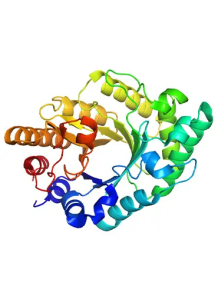Hemicellulase (50,000u/g, Powder)
enzymes that break down hemicellulose—a major component of plant cell walls—into simpler sugars. Their applications span both food processing and dietary supplements, offering multiple benefits
Activation temp: 30-70C (best 40-55C), Activation pH: 3.0-6.5 (best 3.5-5.0)
enzymes that break down hemicellulose—a major component of plant cell walls—into simpler sugars. Their applications span both food processing and dietary supplements, offering multiple benefits
Activation temp: 30-70C (best 40-55C), Activation pH: 3.0-6.5 (best 3.5-5.0)
Hemicellulases are enzymes that break down hemicellulose—a major component of plant cell walls—into simpler sugars. Their applications span both food processing and dietary supplements, offering multiple benefits.
Food Applications
-
Improved Extraction and Clarity:
In juice and wine production, hemicellulases help break down plant material, enhancing the extraction of flavors, pigments, and nutrients. This leads to clearer products and higher yields. For example, in fruit juice processing, the breakdown of hemicellulose releases more juice and improves consistency. -
Enhanced Texture and Baking Performance:
In baking, enzymes like xylanases (a type of hemicellulase) are used to modify dough properties. They improve dough handling, increase bread volume, and yield a softer crumb by partially degrading the cell wall components, which helps in water redistribution throughout the dough. -
Beverage Production:
In brewing and winemaking, hemicellulases contribute to breaking down plant-based substrates, facilitating the release of fermentable sugars and other bioactive compounds. This enzymatic action can result in a more efficient fermentation process and improved flavor profiles.
Dietary Supplement Applications
-
Digestive Support:
Hemicellulases are often included in enzyme blends designed to support digestion. By breaking down complex carbohydrates and fibers found in plant foods, they help improve the bioavailability of nutrients and ease the digestive process. This can be particularly beneficial for individuals who experience bloating or gas from high-fiber diets. -
Prebiotic Potential:
The action of hemicellulases produces smaller oligosaccharides from hemicellulose, which can act as prebiotics. These oligosaccharides serve as food for beneficial gut bacteria, potentially leading to a healthier microbiome and improved gut health.
Health Benefits & Supporting Research
-
Enhanced Nutrient Absorption:
By breaking down the fibrous matrix of plant foods, hemicellulases can improve the accessibility and absorption of vitamins and minerals, contributing to overall nutritional benefits. -
Reduced Gastrointestinal Discomfort:
Improved breakdown of dietary fibers helps mitigate common digestive issues such as bloating and gas. This effect has been observed in clinical studies examining enzyme supplementation in individuals with compromised digestion. -
Gut Microbiota Modulation:
The oligosaccharides generated during hemicellulose degradation may foster the growth of beneficial gut bacteria, supporting immune function and metabolic health. Research has begun to uncover these prebiotic effects, linking them to improved gut health and even potential systemic benefits.
Research Citations
-
Food Processing:
A review by Kumar et al. (2018) details how hemicellulases enhance the extraction of bioactive compounds from plant materials, underscoring their pivotal role in food technology. -
Digestive Enzyme Blends:
Research by Walia et al. (2017) has demonstrated that supplementing diets with enzyme blends containing hemicellulases can improve digestive efficiency and alleviate symptoms like bloating, supporting their use in dietary supplements. -
Prebiotic Effects:
Additional studies (e.g., Singh et al., 2019) have explored the formation of prebiotic oligosaccharides via hemicellulose degradation, linking these compounds to beneficial alterations in the gut microbiota.
Currently, the FDA does not allow it to be used in food. this item It can only be used in food research.
| Mechanism | - |
| Appearance | - |
| Longevity | - |
| Strength | - |
| Storage | - |
| Shelf Life | - |
| Allergen(s) | - |
| Dosage (Range) | - |
| Recommended Dosage | - |
| Dosage (Per Day) | - |
| Recommended Dosage (Per Day) | - |
| Mix Method | - |
| Heat Resistance | - |
| Stable in pH range | - |
| Solubility | - |
| Product Types | - |
| INCI | - |
Purchase History for
Cart
No products



